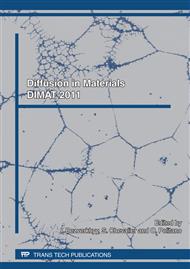p.459
p.465
p.471
p.477
p.485
p.491
p.497
p.503
p.509
Hydrogen Transport in 34CrMo4 Martensitic Steel: Influence of Microstructural Defects on H Diffusion
Abstract:
The electrochemical permeation technique was used to evaluate the effect of the microstructure on hydrogen diffusivity and hydrogen trapping at room temperature in martensitic steels. A detailed study of the electrochemical permeation technique was first performed in order to identify the boundary conditions of a permeation test in the selected experimental set-up. The validity of the apparent diffusion coefficient derived from this test is also discussed. A 34CrMo4 quenched steel has been selected and designed at three tempering temperatures (200°C, 540°C and 680°C) in order to obtain three different microstructures. According to permeation measurements, H diffusion strongly depends on the microstructure. The material tempered at 540°C exhibits the smallest diffusion coefficient and the largest fraction of reversible traps at room temperature.
Info:
Periodical:
Pages:
485-490
Citation:
Online since:
April 2012
Authors:
Keywords:
Price:
Сopyright:
© 2012 Trans Tech Publications Ltd. All Rights Reserved
Share:
Citation:


